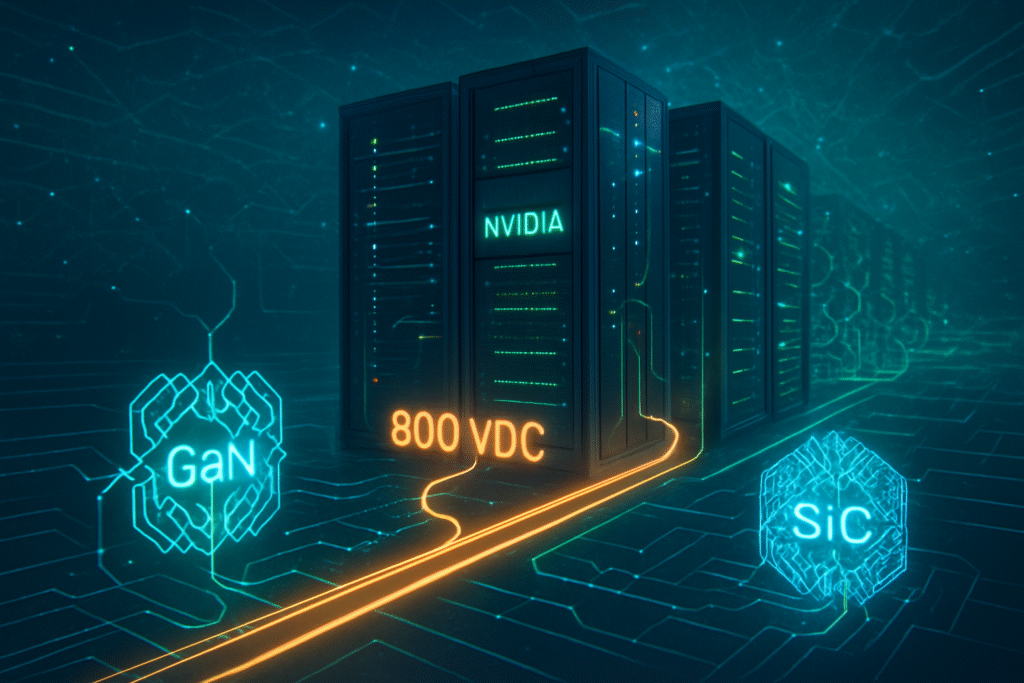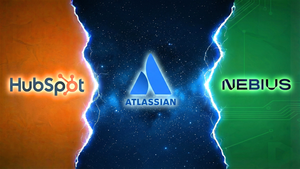
Navitas Semiconductor (NASDAQ: NVTS) today, October 13, 2025, announced a pivotal advancement in its power chip technology, unveiling new gallium nitride (GaN) and silicon carbide (SiC) devices specifically engineered to support NVIDIA's (NASDAQ: NVDA) groundbreaking 800 VDC power architecture. This development is critical for enabling the next generation of AI computing platforms and "AI factories," which face unprecedented power demands. The immediate significance lies in facilitating a fundamental architectural shift within data centers, moving away from traditional 54V systems to meet the multi-megawatt rack densities required by cutting-edge AI workloads, promising enhanced efficiency, scalability, and reduced infrastructure costs for the rapidly expanding AI sector.
This strategic move by Navitas is set to redefine power delivery for high-performance AI, ensuring that the physical and economic constraints of powering increasingly powerful AI processors do not impede the industry's relentless pace of innovation. By addressing the core challenge of efficient energy distribution, Navitas's solutions are poised to unlock new levels of performance and sustainability for AI infrastructure globally.
Technical Prowess: Powering the AI Revolution with GaN and SiC
Navitas's latest portfolio introduces a suite of high-performance power devices tailored for NVIDIA's demanding AI infrastructure. Key among these are the new 100 V GaN FETs, meticulously optimized for the lower-voltage DC-DC stages found on GPU power boards. These GaN-on-Si field-effect transistors are fabricated using a 200 mm process through a strategic partnership with Power Chip, ensuring scalable, high-volume manufacturing. Designed with advanced dual-sided cooled packages, these FETs directly tackle the critical needs for ultra-high power density and superior thermal management in next-generation AI compute platforms, where individual AI chips can consume upwards of 1000W.
Complementing the 100 V GaN FETs, Navitas has also enhanced its 650 V GaN portfolio with new high-power GaN FETs and advanced GaNSafe power ICs. The GaNSafe
power ICs. The GaNSafe devices integrate crucial control, drive, sensing, and built-in protection features, offering enhanced robustness and reliability vital for demanding AI infrastructure. These components boast ultra-fast short-circuit protection with a 350 ns response time, 2 kV ESD protection, and programmable slew-rate control, ensuring stable and secure operation in high-stress environments. Furthermore, Navitas continues to leverage its High-Voltage GeneSiC
devices integrate crucial control, drive, sensing, and built-in protection features, offering enhanced robustness and reliability vital for demanding AI infrastructure. These components boast ultra-fast short-circuit protection with a 350 ns response time, 2 kV ESD protection, and programmable slew-rate control, ensuring stable and secure operation in high-stress environments. Furthermore, Navitas continues to leverage its High-Voltage GeneSiC SiC MOSFET lineup, providing silicon carbide MOSFETs ranging from 650 V to 6,500 V, which support various stages of power conversion across the broader data center infrastructure.
SiC MOSFET lineup, providing silicon carbide MOSFETs ranging from 650 V to 6,500 V, which support various stages of power conversion across the broader data center infrastructure.
This technological leap fundamentally differs from previous approaches by enabling NVIDIA's recently announced 800 VDC power architecture. Unlike traditional 54V in-rack power distribution systems, the 800 VDC architecture allows for direct conversion from 13.8 kVAC utility power to 800 VDC at the data center perimeter. This eliminates multiple conventional AC/DC and DC/DC conversion stages, drastically maximizing energy efficiency and reducing resistive losses. Navitas's solutions are capable of achieving PFC peak efficiencies of up to 99.3%, a significant improvement that directly translates to lower operational costs and a smaller carbon footprint. The shift also reduces copper wire thickness by up to 45% due to lower current, leading to material cost savings and reduced weight.
Initial reactions from the AI research community and industry experts underscore the critical importance of these advancements. While specific, in-depth reactions to this very recent announcement are still emerging, the consensus emphasizes the pivotal role of wide-bandbandgap (WBG) semiconductors like GaN and SiC in addressing the escalating power and thermal challenges of AI data centers. Experts consistently highlight that power delivery has become a significant bottleneck for AI's growth, with AI workloads consuming substantially more power than traditional computing. The industry widely recognizes NVIDIA's strategic shift to 800 VDC as a necessary architectural evolution, with other partners like ABB (SWX: ABBN) and Infineon (FWB: IFX) also announcing support, reinforcing the widespread need for higher voltage systems to enhance efficiency, scalability, and reliability.
Strategic Implications: Reshaping the AI Industry Landscape
Navitas Semiconductor's integral role in powering NVIDIA's 800 VDC AI platforms is set to profoundly impact various players across the AI industry. Hyperscale cloud providers and AI factory operators, including tech giants like Alphabet (NASDAQ: GOOGL), Amazon (NASDAQ: AMZN), Meta Platforms (NASDAQ: META), Microsoft (NASDAQ: MSFT), and Oracle Cloud Infrastructure (NYSE: ORCL), alongside specialized AI infrastructure providers such as CoreWeave, Lambda, Nebius, and Together AI, stand as primary beneficiaries. The enhanced power efficiency, increased power density, and improved thermal performance offered by Navitas's chips will lead to substantial reductions in operational costs—energy, cooling, and maintenance—for these companies. This translates directly to a lower total cost of ownership (TCO) for AI infrastructure, enabling them to scale their AI operations more economically and sustainably.
AI model developers and researchers will benefit indirectly from the more robust and efficient infrastructure. The ability to deploy higher power density racks means more GPUs can be integrated into a smaller footprint, significantly accelerating training times and enabling the development of even larger and more capable AI models. This foundational improvement is crucial for fueling continued innovation in areas such as generative AI, large language models, and advanced scientific simulations, pushing the boundaries of what AI can achieve.
For AI hardware manufacturers and data center infrastructure providers, such as HPE (NYSE: HPE), Vertiv (NYSE: VRT), and Foxconn (TPE: 2317), the shift to the 800 VDC architecture necessitates adaptation. Companies that swiftly integrate these new power management solutions, leveraging the superior characteristics of GaN and SiC, will gain a significant competitive advantage. Vertiv, for instance, has already unveiled its 800 VDC MGX reference architecture, demonstrating proactive engagement with this evolving standard. This transition also presents opportunities for startups specializing in cooling, power distribution, and modular data center solutions to innovate within the new architectural paradigm.
Navitas Semiconductor's collaboration with NVIDIA significantly bolsters its market positioning. As a pure-play wide-bandgap power semiconductor company, Navitas has validated its technology for high-performance, high-growth markets like AI data centers, strategically expanding beyond its traditional strength in consumer fast chargers. This partnership positions Navitas as a critical enabler of this architectural shift, particularly with its specialized 100V GaN FET portfolio and high-voltage SiC MOSFETs. While the power semiconductor market remains highly competitive, with major players like Infineon, STMicroelectronics (NYSE: STM), Texas Instruments (NASDAQ: TXN), and OnSemi (NASDAQ: ON) also developing GaN and SiC solutions, Navitas's specific focus and early engagement with NVIDIA provide a strong foothold. The overall wide-bandgap semiconductor market is projected for substantial growth, ensuring intense competition and continuous innovation.
Wider Significance: A Foundational Shift for Sustainable AI
This development by Navitas Semiconductor, enabling NVIDIA's 800 VDC AI platforms, represents more than just a component upgrade; it signifies a fundamental architectural transformation within the broader AI landscape. It directly addresses the most pressing challenge facing the exponential growth of AI: scalable and efficient power delivery. As AI workloads continue to surge, demanding multi-megawatt rack densities that traditional 54V systems cannot accommodate, the 800 VDC architecture becomes an indispensable enabler for the "AI factories" of the future. This move aligns perfectly with the industry trend towards higher power density, greater energy efficiency, and simplified power distribution to support the insatiable demands of AI processors that can exceed 1,000W per chip.
The impacts on the industry are profound, leading to a complete overhaul of data center design. This shift will result in significant reductions in operational costs for AI infrastructure providers due to improved energy efficiency (up to 5% end-to-end) and reduced cooling requirements. It is also crucial for enabling the next generation of AI hardware, such as NVIDIA's Rubin Ultra platform, by ensuring that these powerful accelerators receive the necessary, reliable power. On a societal level, this advancement contributes significantly to addressing the escalating energy consumption and environmental concerns associated with AI. By making AI infrastructure more sustainable, it helps mitigate the carbon footprint of AI, which is projected to consume a substantial portion of global electricity in the coming years.
However, this transformative shift is not without its concerns. Implementing 800 VDC systems introduces new complexities related to electrical safety, insulation, and fault management within data centers. There's also the challenge of potential supply chain dependence on specialized GaN and SiC power semiconductors, though Navitas's partnership with Power Chip for 200mm GaN-on-Si production aims to mitigate this. Thermal management remains a critical issue despite improved electrical efficiency, necessitating advanced liquid cooling solutions for ultra-high power density racks. Furthermore, while efficiency gains are crucial, there is a risk of a "rebound effect" (Jevon's paradox), where increased efficiency might lead to even greater overall energy consumption due to expanded AI deployment and usage, placing unprecedented demands on energy grids.
In terms of historical context, this development is comparable to the pivotal transition from CPUs to GPUs for AI, which provided orders of magnitude improvements in computational power. While not an algorithmic breakthrough itself, Navitas's power chips are a foundational infrastructure enabler, akin to the early shifts to higher voltage (e.g., 12V to 48V) in data centers, but on a far grander scale. It also echoes the continuous development of specialized AI accelerators and the increasing necessity of advanced cooling solutions. Essentially, this power management innovation is a critical prerequisite, allowing the AI industry to overcome physical limitations and continue its rapid advancement and societal impact.
The Road Ahead: Future Developments in AI Power Management
In the near term, the focus will be on the widespread adoption and refinement of the 800 VDC architecture, leveraging Navitas's advanced GaN and SiC power devices. Navitas is actively progressing its "AI Power Roadmap," which aims to rapidly increase server power platforms from 3kW to 12kW and beyond. The company has already demonstrated an 8.5kW AI data center PSU powered by GaN and SiC, achieving 98% efficiency and complying with Open Compute Project (OCP) and Open Rack v3 (ORv3) specifications. Expect continued innovation in integrated GaNSafe power ICs, offering further advancements in control, drive, sensing, and protection, crucial for the robustness of future AI factories.
power ICs, offering further advancements in control, drive, sensing, and protection, crucial for the robustness of future AI factories.
Looking further ahead, the potential applications and use cases for these high-efficiency power solutions extend beyond just hyperscale AI data centers. While "AI factories" remain the primary target, the underlying wide bandgap technologies are also highly relevant for industrial platforms, advanced energy storage systems, and grid-tied inverter projects, where efficiency and power density are paramount. The ability to deliver megawatt-scale power with significantly more compact and reliable solutions will facilitate the expansion of AI into new frontiers, including more powerful edge AI deployments where space and power constraints are even more critical.
However, several challenges need continuous attention. The exponentially growing power demands of AI will remain the most significant hurdle; even with 800 VDC, the sheer scale of anticipated AI factories will place immense strain on energy grids. The "readiness gap" in existing data center ecosystems, many of which cannot yet support the power demands of the latest NVIDIA GPUs, requires substantial investment and upgrades. Furthermore, ensuring robust and efficient thermal management for increasingly dense AI racks will necessitate ongoing innovation in liquid cooling technologies, such as direct-to-chip and immersion cooling, which can reduce cooling energy requirements by up to 95%.
Experts predict a dramatic surge in data center power consumption, with Goldman Sachs Research forecasting a 50% increase by 2027 and up to 165% by the end of the decade compared to 2023. This necessitates a "power-first" approach to data center site selection, prioritizing access to substantial power capacity. The integration of renewable energy sources, on-site generation, and advanced battery storage will become increasingly critical to meet these demands sustainably. The evolution of data center design will continue towards higher power densities, with racks reaching up to 30 kW by 2027 and even 120 kW for specific AI training models, fundamentally reshaping the physical and operational landscape of AI infrastructure.
A New Era for AI Power: Concluding Thoughts
Navitas Semiconductor's announcement on October 13, 2025, regarding its new GaN and SiC power chips for NVIDIA's 800 VDC AI platforms marks a monumental leap forward in addressing the insatiable power demands of artificial intelligence. The key takeaway is the enablement of a fundamental architectural shift in data center power delivery, moving from the limitations of 54V systems to a more efficient, scalable, and reliable 800 VDC infrastructure. This transition, powered by Navitas's advanced wide bandgap semiconductors, promises up to 5% end-to-end efficiency improvements, significant reductions in copper usage, and simplified power trains, directly supporting NVIDIA's vision of multi-megawatt "AI factories."
This development's significance in AI history cannot be overstated. While not an AI algorithmic breakthrough, it is a critical foundational enabler that allows the continuous scaling of AI computational power. Without such innovations in power management, the physical and economic limits of data center construction would severely impede the advancement of AI. It represents a necessary evolution, akin to past shifts in computing architecture, but driven by the unprecedented energy requirements of modern AI. This move is crucial for the sustained growth of AI, from large language models to complex scientific simulations, and for realizing the full potential of AI's societal impact.
The long-term impact will be profound, shaping the future of AI infrastructure to be more efficient, sustainable, and scalable. It will reduce operational costs for AI operators, contribute to environmental responsibility by lowering AI's carbon footprint, and spur further innovation in power electronics across various industries. The shift to 800 VDC is not merely an upgrade; it's a paradigm shift that redefines how AI is powered, deployed, and scaled globally.
In the coming weeks and months, the industry should closely watch for the implementation of this 800 VDC architecture in new AI factories and data centers, with particular attention to initial performance benchmarks and efficiency gains. Further announcements from Navitas regarding product expansions and collaborations within the rapidly growing 800 VDC ecosystem will be critical. The broader adoption of new industry standards for high-voltage DC power delivery, championed by organizations like the Open Compute Project, will also be a key indicator of this architectural shift's momentum. The evolution of AI hinges on these foundational power innovations, making Navitas's role in this transformation one to watch closely.
This content is intended for informational purposes only and represents analysis of current AI developments.
TokenRing AI delivers enterprise-grade solutions for multi-agent AI workflow orchestration, AI-powered development tools, and seamless remote collaboration platforms.
For more information, visit https://www.tokenring.ai/.


















